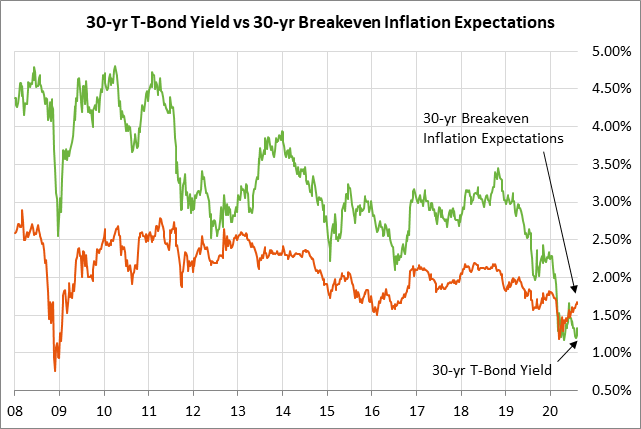- Inflation expectations return to pre-pandemic levels
- Markets brace for U.S./China trade meeting
- Mnuchin-Pelosi telephone call ends in acrimony with no prospects for new negotiations
- Unemployment claims expected to improve
- Treasury auctions record-sized 30-year T-bond
Inflation expectations return to pre-pandemic levels — Inflation expectations are back to pre-pandemic levels, which is bad news for the Treasury market. The 10-year breakeven inflation expectations rate on Wednesday rose by +4 bp to 1.67%, reaching a new 5-3/4 month high and rising above the average of 1.65% seen in Q4-2019 before the pandemic started to emerge in early 2020.
The 10-year breakeven rate was pushed higher on Wednesday by the +2.55% rally in Sep WTI crude oil prices and by a stronger-than-expected CPI report. The July CPI rose by +0.6% m/m and +1.0% y/y, which was much stronger than expectations of +0.3% m/m and +0.7% y/y. The July core CPI rose by +0.6% m/m and +1.6% y/y, which was much stronger than expectations of +0.2% m/m and +1.1% y/y.
The rise in the July CPI may be only temporary as the prices recover from the pandemic-induced dip. Nevertheless, the higher inflation statistics mean that the Fed is on much thinner ice with its argument that it must keep interest rates near zero and continue with its $120 billion per month QE program. If inflation were to unexpectedly keep surging, then the Fed would have no alternative but to start reining in its extraordinarily easy monetary policy.
The rise in inflation expectations is particularly alarming for T-note investors, who are buying Treasury securities with yields so far below inflation expectations that they are almost guaranteed to lose money on an inflation-adjusted basis. Indeed, the real 10-year T-note yield, as illustrated by the 10-year TIPS security, is currently trading at -0.99%, meaning that investors are paying the Treasury nearly one full percentage point simply to warehouse their money.
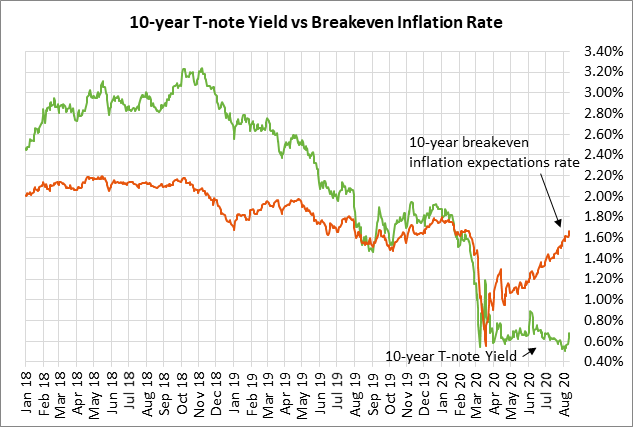
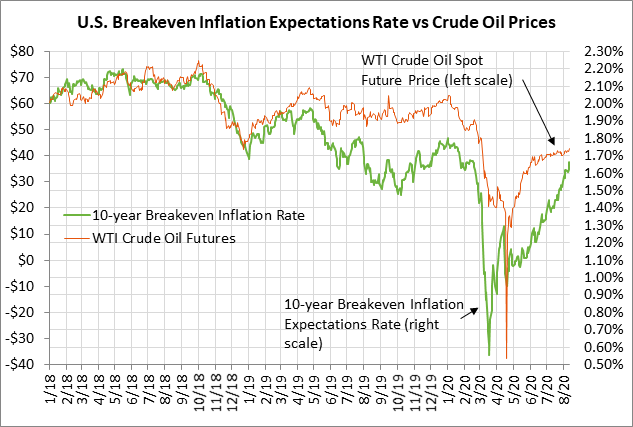
Markets brace for U.S./China trade meeting — The markets are braced for the U.S./China trade meeting that is being held as the pre-agreed 6-month review of the phase-one trade deal. The Wall Street Journal reported earlier this week that the meeting will be held this Saturday, Aug 15. However, Bloomberg on Wednesday reported that the meeting could take place this week but that a date has not been finalized.
The meeting is expected to be a teleconference among USTR Lighthizer, Treasury Secretary Mnuchin, and Chinese Vice Premier Liu, who were the principals that negotiated the phase-one trade deal.
President Trump so far continues to support the phase-one trade deal and appears willing to overlook the fact that China’s buying of U.S. products is far behind schedule. White House economic advisor Kudlow on Tuesday said that the U.S./China trade deal is “fine” and that China is “substantially” increasing its purchases of U.S. products.
China in the first half of 2020 bought only $33.1 billion of U.S. goods, little changed from the comparable year-earlier level and less than half of the target of $71 billion that China needed to hit by mid-year in order to meet its full-year buying commitment, according to figures provided by Bloomberg.
The U.S. stock market has largely overlooked the sharp deterioration of U.S./Chinese relations in the past several months. However, if the U.S./China phase-one trade deal breaks down, then the U.S. stock market is likely to fall sharply since President Trump would undoubtedly launch a new round of tariffs against Chinese products and China would retaliate with higher tariffs on U.S. products.
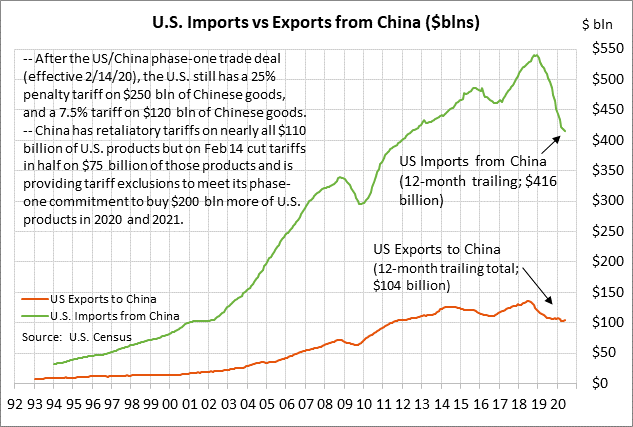
Mnuchin-Pelosi telephone call ends in acrimony with no prospects for new negotiations — The chances for a pandemic deal in August are growing slimmer by the day. Treasury Secretary Mnuchin and Speaker Pelosi held a phone call Wednesday but both sides indicated they would give no ground from their last positions. Ms. Pelosi said there is a “chasm” between the two sides.
The White House is trying to implement the President’s executive orders for a $300 per week unemployment bonus, a deferral of the payroll tax, eviction protections, and an extension of student loan forbearance until year-end.
Democrats are sticking to a $2 trillion top-line bill, a $600 per week unemployment bonus, and more than $900 billion of state-local aid. Meanwhile, Republicans are sticking to a maximum bill size of $1 trillion, a $400 per week unemployment bonus, and a Covid liability shield for businesses, schools, and organizations.
When Congress returns from their August recess after Labor Day, there will be only a few weeks left to produce a spending bill for fiscal 2021, or there will be another federal government shutdown on October 1, 2020. The negotiations over new spending authorization may get tangled up with a new push for pandemic aid.
Unemployment claims expected to improve — The consensus is for today’s initial unemployment claims report to show a -86,000 decline to 1.100 million, adding to last week’s decline of -249,000 to 1.186 million. Meanwhile, continuing claims are expected to drop -307,000 to 15.800 million, adding to last week’s decline of -844,000 to 16.107 million. The total number of people on the unemployment rolls has dropped from May’s peak, but there are still 14.4 million more people on unemployment than before the pandemic.
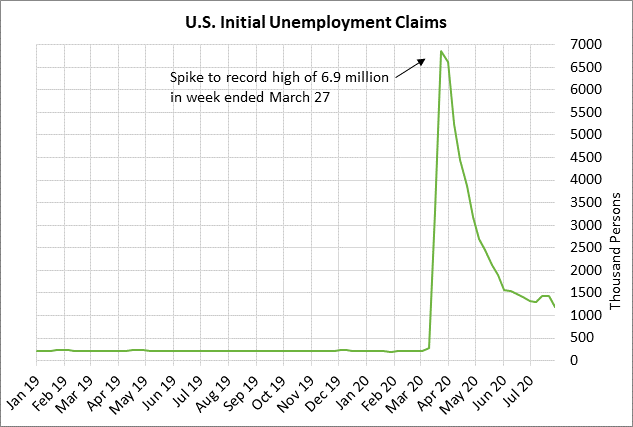
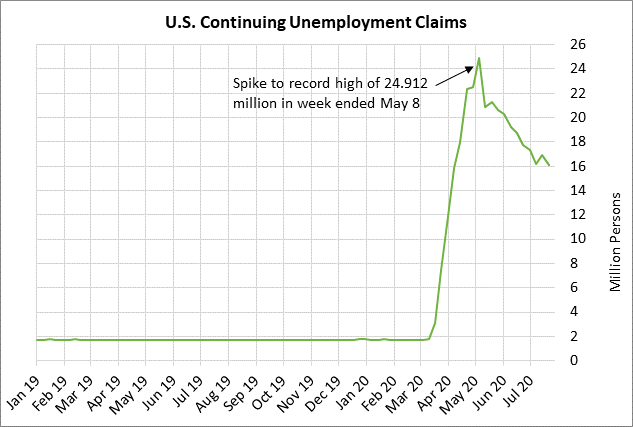
Treasury auctions record-sized 30-year T-bond — The Treasury today will sell $26 billion of 30-year T-bonds, concluding this week’s $112 billion quarterly refunding operation. The size of today’s auction is $4 billion larger than the $22 billion size at the last refunding operation in May. Today’s 30-year T-bond was trading at 1.37% late yesterday.
